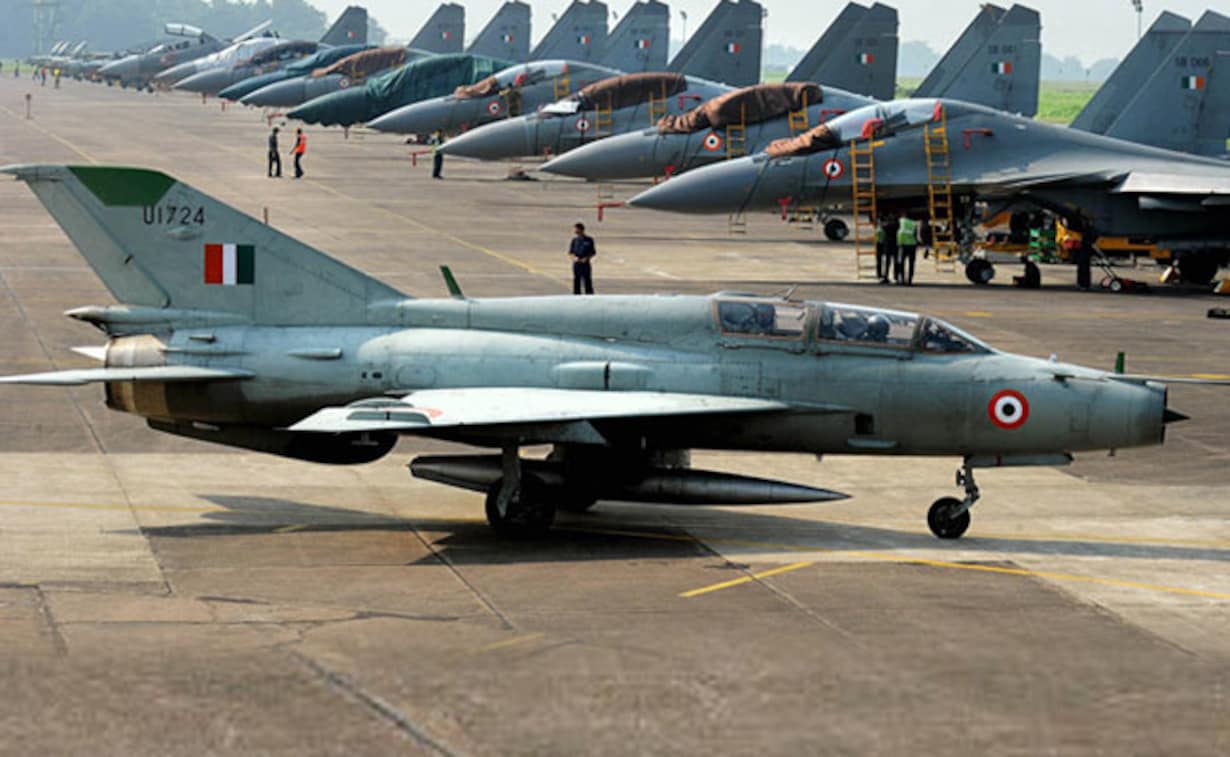
Our trainee fighter pilots still fly the MIG aircrafts which are vintage though over 400 MiG-21 aircraft of the Indian Air Force have crashed in the last 60 years, claiming the lives of over 200 pilots and 60 civilians. A special report by Narvir Rooprai
The National Green Tribunal (NGT) bench comprising Justice Adarsh Kumar Goel and Justice Sudhir Agarwal sometime back dismissed a plea seeking an exemption from the ban on 10-year-old diesel and 15-year-old petrol vehicles in Delhi-NCR in line with a decision by the Supreme Court. Ironically, however, our trainee fighter pilots still fly the MIG aircrafts which are vintage though over 400 MiG-21 aircraft of the Indian Air Force have crashed in the last 60 years, claiming the lives of over 200 pilots and 60 civilians.
On July 29 a crash in Rajasthan’s Barmer involved this older Type 96 variant of MiG-21, a twin-seat trainer used to prepare young pilots just posted into the Squadron after finishing their basic and advanced jet training. Wing Commander M. Rana (38) and Flight Lieutenant Advitiya Bal (26) were killed in the accident.
However, it was not a freak incident. The figures are frightening: Reportedly, “of the 872 MiG-21s progressively inducted by IAF, over 400 have been lost in accidents since 1971-72, killing over 200 pilots and almost 60 civilians on the ground”. At least six MiG-21s have crashed since January last year, killing five pilots. According to the reports, the MiG-21 had completed its retirement period in the mid-1990s.
Official view
Every time a crash takes place, where young pilots die, leaving behind their widows, small children or vailing parents behind, authorities get away by making suitable statements. This incident was no exception and the Indian Air Force issued a statement. It said, “A twin seater Mig-21 trainer aircraft of the IAF was airborne for a training sortie from Uttarlai air base in Rajasthan this evening. Around 9:10 pm, the aircraft met with an accident near Barmer. Both pilots sustained fatal injuries. IAF deeply regrets the loss of lives and stands firmly with the bereaved families.” As per information released by the IAF, this was a trainer version of the fighter aircraft with two pilots on board. As is the norm for training missions, there was one senior pilot, Wing Commander M Rana, on board along with a junior pilot, Flight Lieutenant Adivitya Bal. The typical mission in such sorties is to impart operational training to the junior pilots and also to test their skills in a constant effort to keep their skills and knowledge up to date and to suggest improvements if any. A court of inquiry has been ordered to investigate the cause of the accident, it said.
There are four squadrons of MiG-21 Bison aircraft currently in service in the IAF with each squadron comprising 16-18 aircraft, including two trainer versions. Out of these, one squadron, Srinagar-based No 51 Squadron, is going to be retired from service or ‘number plated’ in IAF jargon on September 30 this year, leaving three squadrons in service. Out of these three squadrons, one will be number plated each year and, thus, MiG-21 Bison will be phased out of IAF by 2025. The IAF is looking towards reviving these squadrons back into service with the indigenous Light Combat Aircraft (LCA) Tejas. The MiG-21 Bison is an upgraded version of the MiG-21bis which had been first inducted into service in 1976. The MiG-21 FL, which was an older version of the aircraft and which joined service in the early 1960s, had been phased out of IAF in 2013. The IAF received the first upgraded MiG-21 Bison, which had a quantum leap of upgrade of avionics, in 2001 and the last of these upgraded fighters was received in 2008.
The Bison version of the MiG-21 has also seen the induction of women fighter pilots in the IAF with Flying Officer Avani Chaturvedi becoming the first woman pilot of the IAF to complete a solo flight on the aircraft in June 2016. The MiG-21 aircraft, with all its versions, formed the backbone of the fleet of fighter aircraft of the IAF, and the number of crashes that took place in the IAF were the highest in its category. Most of these versions had been licence-produced in India.
Flying Coffin
There were many inquiries into the crashes amidst allegations of poor safety record of these aircraft with a large number of pilots having lost their lives in accidents. More than 20 aircraft have crashed since 2010 and 38 aircraft crashed between 2003 and 2013 in a period of ten years. The high rate of accidents earned the aircraft the nickname of ‘Flying Coffin”. In September 2001, a MiG-21bis crash in Suratgarh claimed the life of Flight Lieutenant Abhijeet Gadgil soon after take-off. There was a controversy when the pilot’s mother, Kavita Gadgil, raised the issue of technical defects in the aircraft and said that her son was being wrongly blamed for the crash. She received a letter from the then Inspector General of Flight Safety of IAF, Air Marshal Ashok Goyal, accusing her of demoralising the IAF with her statements. Later, the then Air Chief, Air Chief Marshal S P Tyagi, apologised for the tone of the letter and wrote to Kavita Gadgil withdrawing it and absolving her son of any blame.
View of former IAF chief
Former IAF chief, Air Chief Marshal BS Dhanoa, observed that he would have “liked to retire the MiG-21 early,” he could not since the air force simply didn’t have the planes as procurement programs were mired in bureaucratic hurdles. According to reports, the MiG-21 had completed its retirement period in the mid-1990s.
For record, as against an ideal required strength of 42 squadrons (with 18 jets to a squadron) to thwart a dual threat from Pakistan and China, the IAF has been making do with 33 squadrons. Also the aircrafts that have outlived their lifespan are still flyable if they are assessed to be “serviceable.” This indicates that the years of wear and tear can still be mitigated by the aircraft having repairable and replaceable spares.
In Air Force parlance, obsolete does not mean unserviceable. When an old aircraft is flying, it means it has been found to be serviceable and flight-worthy. “When the two pilots signed the logbook, and the jet taxied out onto the runway, it must have been deemed fit to fly,” said Dhanoa. Dhanoa, however, adds that the rate of accidents per 100,000 hours of flying is still low. The IAF had planned to phase out around 70 MiG-21′ Bisons. This involved the Srinagar-based ’51 Sword Arms Squadron’, and three other Squadrons at Uttarlai, Suratgarh and Nal in Rajasthan.
The way forward
The Soviets designed the MiG-21 in the 1960s as a supersonic interceptor at the height of the Cold War to take out American bombers. IAF pilots were unaccustomed to the delta-wing aerodynamics and initially mishandled the aircraft. A whopping landing speed of 366 km was another unusual feature. The thin delta-wing resulted in a flight condition known as ‘super-stall’, where the MiG-21 used to sink at a rapid rate of 100-150 meters per second, losing about 20-30,000 feet within a minute.
Air Force veterans say that modernisation will have a cost but losing trained young pilots is a blow on everybody’s morale. The government needs to prioritise and act fast. They opine that if ‘thousands of crores’ of rupees can be provisioned for subsidies or the banks can write off ‘lakhs of crores’ of rupees as NPAs of corporate cronies, they sure can divert their attention to modernisation and get rid of the so called flying coffins.













